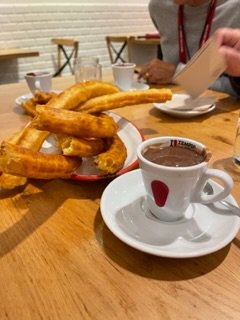Before I regale you with today’s touring excerpts, we were told by our local guide this morning that the stormy weather we experienced when we arrived on Thursday from the airport was actually the worst storm that Madrid has seen since weather records were recorded. I told you… it was a huge storm!!
Anyway, today we visited El Escorial, which was built between 1563 and 1584 by King Philip II. (We were not allowed to take any photos inside the buildings, but I do encourage you to google the site and see the amazing art works!)
The El Escorial is the largest Renaissance building in the world. El Escorial was both a Spanish royal palace and a monastery, although Philip II is the only monarch who ever lived there. The building took over 21 years to complete, and to this day, when a job takes longer than necessary, “la obra de El Escorial” is a proverbial expression meaning “something that takes a long time to complete”.
The building itself, made from granite, is quite austere and definitely did not have the makings of an ornate palace.
El Escorial has been the burial site for most of the Spanish kings from the last five centuries, and we went into the different crypts…of which there are many…to visit with the kings as well as the queens, princes, and princesses.
The floor plan of the building is in the form of a gridiron. This gridiron motif surfaced many times in paintings, upholstery, tapestry, etc. that we saw on the tour, and it was symbolic of St Lawrence who, in the third century AD, was martyred by being roasted to death on a grill. YIKES!
We toured many beautiful rooms, and admired the stunning frescoes and tapestries (some created by Goya), that adorned the walls. Since today was Saturday, we couldn’t go into the church since weddings were taking place, so instead we were invited to rooms that visitors normally are not allowed to visit.
Philip lived on and off in the Escorial for 14 years. We visited his bedroom and the bed where he died, which prior to his death, allowed him a view of the high altar, and to see mass being celebrated while in bed.
Today, El Escorial is a UNESCO World Heritage site and functions as a monastery, basilica, royal palace, pantheon, library, museum, university, school, and hospital.
It was a lot of walking, so we were grateful when the tour ended and we were back in the bus. We had a quick lunch and then it was off with the guide for a tour around the old city of Madrid.
The architecture is amazing and the balconies that are on almost every building are beautiful.
We finished off the tour in a pastry shop and we were served thick hot chocolate along with churros to dip in it.
We have a very early day tomorrow, so we had a quick dinner and it’s off to bed. Interestingly, the Spaniards have their lunch or main meal at around 4 pm and dinner doesn’t start until around 9 or 10. The restaurants become very crowded at those times, so having an early lunch as well as dinner today, benefited us very well.



The old city of Madrid

